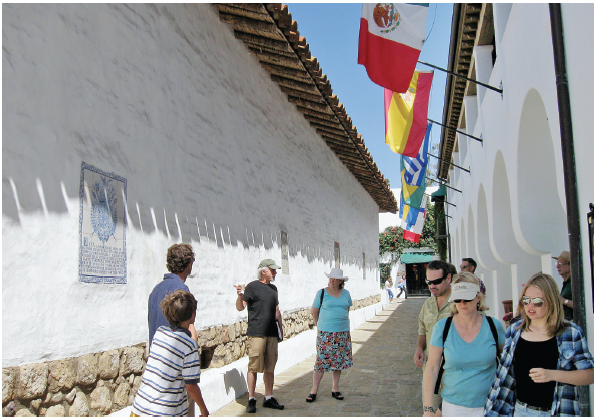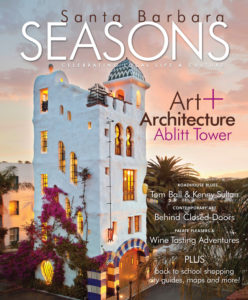
Bibi Ji interior, photo by Collin Dewell.
An innovative take on Indian food paired with locally made wines and locally sourced seafood with Australian influences all adds up to what is easily one of the most exciting new restaurants to hit downtown Santa Barbara in a long, long time!
Bibi Ji, the new restaurant from James Beard Award-winning sommelier Rajat Parr (who also makes his own wine labels—Domaine de la Cote and Sandhi—nearby in Lompoc) and acclaimed Chef Jessi Singh (who’s been lauded for his inventive “unauthentic” Indian cooking at the popular Babu Ji restaurants in San Francisco, Manhattan and Melbourne) opened this month at 734 State St., a beautiful location across from Paseo Nuevo with an outdoor courtyard overlooking De La Guerra Plaza.

Bibi Ji Coconut Curry with Shrimp, courtesy photo.
The name Bibi Ji—an Indian term of endearment for women in the family—pays tribute to the formative women in both Singh and Parr’s lives who cultivated their love for food and hospitality.
Drawing from his Australian and Indian roots, Chef Singh (who now lives in Santa Barbara) has created a menu featuring his self-proclaimed “unauthentic take” on many traditional American seafood dishes, with a strong focus on using local Santa Barbara purveyors. With the Santa Barbara Farmers Market just steps away, Singh is excited to change his menu regularly depending on what’s available in the market that week.
Currently on the menu are SB UNI Biryani, made with local sea urchin and fried rice—a dish so beautiful plated it looks like a mythical sea creature; Local Oysters with green mango pickle butter (from famed Santa Barbara fish monger Stephanie Mutz); delicious Hope Ranch Black Mussels in a curry broth; and melt-in-your-mouth Aussie Lamb Chops with mint and dill raita and apricot chutney.

Bibi Ji interior, photo by Collin Dewell.
We also enjoyed a zesty array of “unauthentic curries,” such as Beef Korma with beef short rib, curry leaves, cashew and hearty shiitake mushrooms; Unauthentic CTM, Chef Singh’s delicious riff on chicken tikka masala; Coconut Curry with turmeric and mustard seeds and pink shrimp, a dish I’m still dreaming about, even though I normally am not a coconut lover; Chana Masala, with chickpea, dry pomegranate and green mango powder; Punjabi Kadhi, with fenugreek and turmeric yogurt curry; and Bibi Ji Daal, with ginger, garlic and tomatoes.

Bibi Ji’s SB UNI Biryani, courtesy photo.
Favorite dishes from Singh’s Babu Ji restaurants in New York and San Francisco are also on the menu, like Mr. Tso’s Cauliflower, Indo-Chinese style cauliflower in a tomato & chili sauce, and Gol Gappa, delicious tangy crispy stuffed shells.
The Chef’s Tasting Menu—offering a variety of favorite appetizers, curries, naan, rice and dessert for $50 per person—is an excellent way to savor a variety of these exciting flavors without having to make a lot of decisions.

Crudo from Bibi Ji, courtesy photo.
In addition to a “serve yourself” assortment of beers which made my husband’s heart sing, Bibi Ji’s carefully curated wine offerings are designed to complement the playful menu. The wines focus on highlighting organic, biodynamic and natural wines from artisanal producers in Europe, Australia and Santa Barbara. At the moment, producers include Gonon, Jean Michel Stephane, Allemand, Metras, Laporte and Richard Leroy, with varietals ranging from Gamay and Syrah to Riesling and Chenin Blanc, which pair well with the spices in many of the dishes.
Nearly all of the wines at the restaurant will also be available at Bibi Ji’s bottle shop, which is located inside the restaurant and offers an esoteric collection of more than 100 bottles.

Bibi Ji patio, photo by Collin Dewell.
The inviting interior, designed by Chef Singh, features a 40-seat dining room with exposed brick, high ceilings adorned with hanging golden chandeliers and a skylight that brings natural light into the space. A brown leather banquette spans along one side of the restaurant, and on the other side is the 15-seat bar. Pops of color come from red-cushioned dining chairs and bar stools, as well as from the vibrant Indian artwork that decorates the walls. Empty wine bottles, sourced from Parr’s personal collection, are showcased throughout the restaurant.
Bibi Ji is open daily from 11 a.m. to 10 p.m. For more information, visit bibijisb.com or call 805/560-6845.
Originally published in Santa Barbara Seasons on March 2, 2018.






